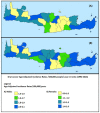Evidence-Based Conceptual Collection of Methods for Spatial Epidemiology and Analysis to Enhance Cancer Surveillance and Public Health
- PMID: 36232065
- PMCID: PMC9566360
- DOI: 10.3390/ijerph191912765
Evidence-Based Conceptual Collection of Methods for Spatial Epidemiology and Analysis to Enhance Cancer Surveillance and Public Health
Abstract
(1) Background: Although spatial statistics are often used by cancer epidemiologists, there is not yet an established collection of methods to serve their needs. We aimed to develop an evidence-based cancer-oriented conceptual collection of methods for spatial analysis; (2) Methods: A triangulation of approaches was used; literature review, consensus meetings (expert panel), and testing the selected methods on "training" databases. The literature review was conducted in three databases. This approach guided the development of a collection of methods that was subsequently commented on by the expert panel and tested on "training data" of cancer cases obtained from the Cancer Registry of Crete based on three epidemiological scenarios: (a) low prevalence cancers, (b) high prevalence cancers, (c) cancer and risk factors; (3) Results: The final spatial epidemiology conceptual collection of methods covered: data preparation/testing randomness, data protection, mapping/visualizing, geographic correlation studies, clustering/surveillance, integration of cancer data with socio-economic, clinical and environmental factors. Some of the tests/techniques included in the conceptual collection of methods were: buffer and proximity analysis, exploratory spatial analysis and others. All suggested that statistical models were found to fit well (R2 = 0.72-0.96) in "training data"; Conclusions: The proposed conceptual collection of methods provides public health professionals with a useful methodological framework along with recommendations for assessing diverse research questions of global health.
Keywords: cancer; cancer surveillance; chronic diseases; environmental epidemiology; global health; respiratory diseases; spatial epidemiology; spatial statistics.
Conflict of interest statement
The authors declare no conflict of interest.
Figures




References
-
- Olsen J., Nøhr E.A., Thomsen R.W., Støvring H. Non-communicable disease epidemic: Epidemiology in action (EuroEpi 2013 and NordicEpi 2013) Methods. 2013;12:1–8.
-
- World Health Organization Global Health Observatory Data Repository. Global Health Estimates: Leading Causes of Death. 2015. [(accessed on 16 July 2022)]. Available online: https://www.who.int/data/gho/data/themes/mortality-and-global-health-est....
-
- Bray F. Transitions in human development and the global cancer burden. In: Wild C.P., Stewart B., editors. World Cancer Report 2014. International Agency for Research on Cancer; Lyon, France: 2014. pp. 54–68.
Publication types
MeSH terms
LinkOut - more resources
Full Text Sources
Medical

